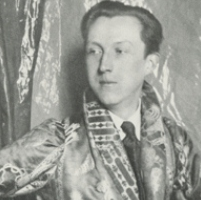
Dame Edith Louisa Sitwell was a British poet and critic and the eldest of the three literary Sitwells. She reacted badly to her eccentric, unloving parents and lived much of her life with her governess. She never married but became passionately attached to Russian painter Pavel Tchelitchew, and her home was always open to London's poetic circle, to whom she was generous and helpful.

Sir Sacheverell Reresby Sitwell, 6th Baronet, was an English writer, best known as an art critic, music critic, and writer on architecture, particularly the baroque. Dame Edith Sitwell and Sir Osbert Sitwell were his older siblings.

The Sitwells, from Scarborough, North Yorkshire, were three siblings who formed an identifiable literary and artistic clique around themselves in London in the period roughly 1916 to 1930. This was marked by some well-publicised events, notably Edith's Façade with music by William Walton, with its public debut in 1923. All three Sitwells wrote; for a while their circle was considered by some to rival Bloomsbury, though others dismissed them as attention-seekers rather than serious artists.

Sir Francis Osbert Sacheverell Sitwell, 5th Baronet CH CBE was an English writer. His elder sister was Edith Sitwell and his younger brother was Sacheverell Sitwell. Like them, he devoted his life to art and literature.

Renishaw Hall is a country house in Renishaw in the parish of Eckington in Derbyshire, England. It is a Grade I listed building and has been the home of the Sitwell family for nearly 400 years. The hall is southeast of Sheffield, and north of Renishaw village, which is northeast of Chesterfield.

Weston Hall is a 17th-century manor house in Weston, Northamptonshire. The house was owned by the Sitwell family's ancestors from 1714 to 2021. It is a Grade II* listed building.

Sir George Reresby Sitwell, 4th Baronet was a British antiquarian writer and Conservative politician who sat in the House of Commons between 1885 and 1895.

Hans Place is a garden square in the Knightsbridge district of the Royal Borough of Kensington and Chelsea, London, immediately south of Harrods in SW1. It is named after Sir Hans Sloane, 1st Baronet, PRS, physician and collector, notable for his bequest, which became the foundation of the British Museum.

Cadogan Place is a street in Belgravia, London. It is named after Earl Cadogan and runs parallel to the lower half of Sloane Street. It gives its name to the extensive Cadogan Place Gardens, private communal gardens maintained for Cadogan residents. It is owned by Cadogan Estates.

St George's Square is a prestigious and very long garden square in affluent Pimlico, Central London. It benefits from gardens and a church in its central area. Near the northern acute angle, the square is intersected by Lupus Street. Pimlico tube station is a short distance east. Its north-east side is in effect Belgrave Road and southern side is arterial Grosvenor Road which is lined by a small public garden in front of the River Thames.

South Audley Street is a major shopping street in Mayfair, London. It runs north to south from the southwest corner of Grosvenor Square to Curzon Street.
David Stuart Horner was a crime fiction novelist and the longtime partner of Osbert Sitwell.

Brompton Square is a garden square in London's Brompton district, in the Royal Borough of Kensington and Chelsea.

Oakley Street is in the Royal Borough of Kensington and Chelsea, London. It runs roughly north to south from King's Road to the crossroads with Cheyne Walk and the River Thames, where it continues as the Albert Bridge and Albert Bridge Road. The street was named after Baron Cadogan of Oakley.

Cheyne Row is a residential street in Chelsea, London.

Ovington Square is a garden square in central London's Knightsbridge district. It lies between Brompton Road to the north-west and Walton Street to the south-east.

Curzon Street Baroque is a 20th-century inter-war Baroque revival style. It manifested itself principally as a form of interior design popular in the homes of Britain's wealthy and well-born intellectual elite. Its name was coined by the English cartoonist and author Osbert Lancaster, as Curzon Street in Mayfair was an address popular with London high society. While previous forms of Baroque interior design had relied on French 18th-century furnishings, in this form it was more often than not the heavier and more solid furniture of Italy, Spain, and southern Germany that came to symbolise the furnishings of new fashion.

Tedworth Square is a garden square in London's Chelsea district, SW3. The communal garden at the centre of the development is 0.1962 hectares in size.

Alexander Square is a garden square in London's Chelsea district, SW3. The communal garden at the centre of the development is 0.1226 hectares in size.

Wellington Square is a garden square in Chelsea, London, off the south side of the King's Road. It was built in the first decades of the nineteenth century on the former site of a nursery owned by the florist and "well-known tulip-fancier" Thomas Davey and named after the Duke of Wellington. The square consists of 35 five-storey terraced stucco houses around a central garden with a fountain. The whole square is grade II listed with Historic England.


















